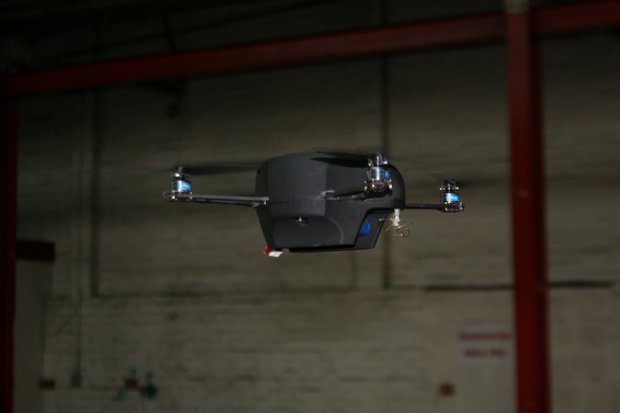One of the smallest unmanned drones in the world has the diameter of a Frisbee, fits in the palm of a hand, and looks like a miniature Star Wars X-wing. The SQ-4 UAV isn't just a tiny surveillance vehicle; it's also on the cutting edge of the new wave of nanodrones.

Drones, or unmanned aerial vehicles (UAV), are big business these days. One of the newest areas of drone development is the construction of nano unmanned aerial systems (NUAS)--tiny, flying spy vehicles that fit snugly in your palm. While they look like remote-controlled toys, NUAS vehicles are sophisticated surveillance devices perfect for discreet use in crowded cities. These drones, along with the slightly larger models known as “micro” drones, are a fast-growing field for arms manufacturers.
While much has been written about DARPA's recent hummingbird-sized UAV, another handheld model released by a British firm looks like, well, a miniature Star Wars X-wing fighter. BCB International's SQ-4 drone weighs only 2.9 ozs., flies up to 400 feet in the air, fits in the palm of a hand, contains two video cameras, can hover in place and perch on ledges, and automatically returns “home” when its battery runs low.
The SQ-4, which was developed by a team at London's Middlesex University's Autonomous Weapons Laboratory, debuted this fall at the Defence & Security Equipment International conference in London. Right now, the UAV comes in two separate models: a full-function “recon” model with two cameras and a 4,900-foot flying range that weighs 7 ounces, and a super-miniaturized version with one camera and a 1,640-foot flying range that weighs 2.9 ounces. Both models are controlled via a remote control that looks like something out of a 1980s sci-fi movie (see below).
According to BCB project manager Barry Davies, the drones are designed for discreet surveillance and reconnaissance tasks in urban settings. The drones hover silently and send video footage back to the operator and automatically begin to fly back to their launch point once the battery meter drops to 30% or the operator begins to lose control. A separate device from the remote control displays a live video feed on a seven-inch screen for the mission commander. Both the drone and accessories are designed to comfortably fit in a standard-size backpack.
While the central portion of the drone is handheld, the entire diameter of the UAV--including “wings”--is about the diameter of a Frisbee. The small weight of the drones means that they even have the ability to perch, birdlike, on ledges and building ornaments.
There's big money in the development of nano and micro-UAVs right now; two of the big players in the field are the British and Indian governments. Britain's Defence Ministry has earmarked 20 million pounds to purchase nanodrones for Afghan deployment, while the Indian government also seeks to build their own fleet of miniature UAVs. Meanwhile, the United States, Israel, and China also boast massive UAV industries of their own.
Demand for these new, miniaturized UAVs is only going to grow in the near future. The growing American budget for “homeland security” programs means law enforcement agencies nationwide have received immense amounts of discretionary cash to spend on all sorts of technological innovations.
Growing American border concerns are also contributing to demand; drug-related violence on the Mexican border and ongoing human trafficking mean plenty of bulk drone buys on behalf of the federal government. Meanwhile, Afghanistan is not going away, and there's that pesky matter of whether Iranian nuclear ambitions or the European financial crisis will spark a major war in the next five years. In other words, the market for handheld drones should remain aflutter for quite a while.
[Images: BCB International]
For more stories like this, follow @fastcompany on Twitter. Email Neal Ungerleider, the author of this article, here or find him on Twitter and Google+.